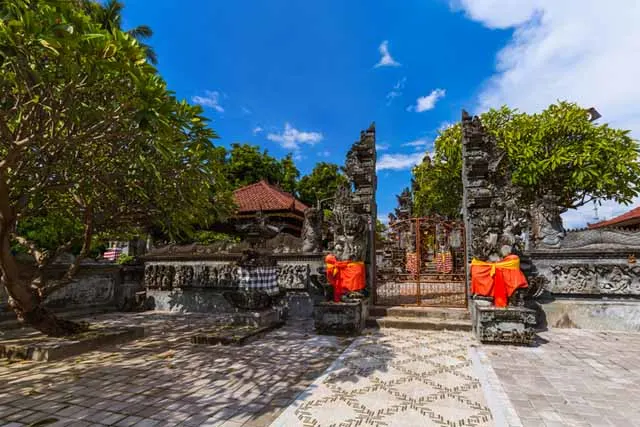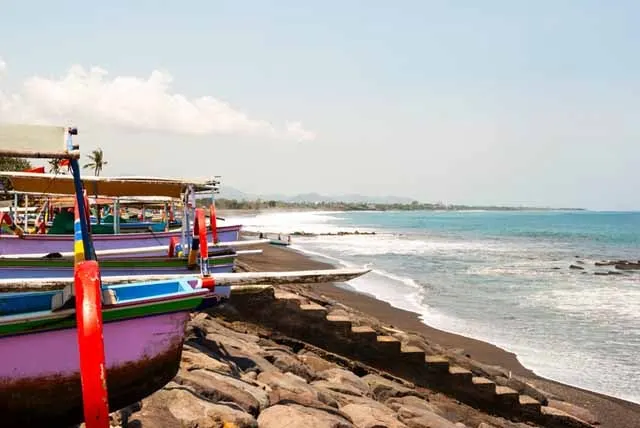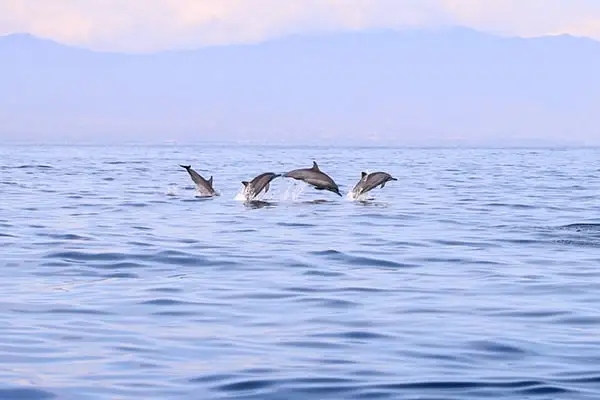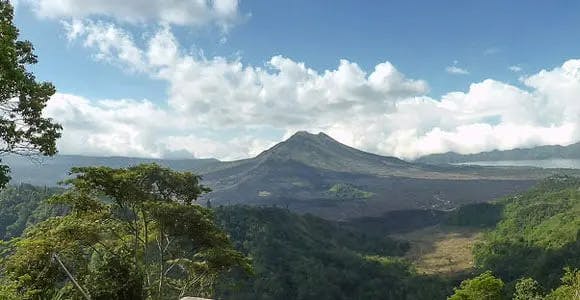By Josephine Brierley
Many people arrive on the island of Bali and only visit the southern tip. Drive three hours north and you’ll discover the scenic area of Lovina. A beachside town bordered by black-sand beaches and lush, green mountains, and without the hustle and bustle of the south. Low-rise buildings and beaches which are calm and tranquil, add to the uniqueness of Lovina.
The area spans seven traditional villages, which all merge over six miles of road to the west of the major town of Singaraja. The north of Bali is known for its diving hotspots, and as is the case across most of Bali, Lovina enjoys warm, tropical weather all year round. During January and February, the wet season can bring heavy rainfall, and the coolest month is August.
Retire in Lovina

The expat community in Lovina is relatively small compared to other areas in Bali. It’s easy to live a very simple existence, and while traditional Balinese life is prominent here, modern conveniences can easily be found. There are local food markets open daily in Lovina, Seririt, and Singaraja. These markets are a great place to interact with the locals, and walk away loaded with fruits, vegetables, and fresh produce at bargain prices.
The market within Lovina is small but full of life. You can barter, but it’s good to remember they are making a living too. The best way to get a guide of prices is to stand behind the locals and see what they are paying for items before you buy them. You can cook at home very economically, with a week’s worth of fresh fruit and vegetables costing around $15.
Supermarket shopping is also easy. As well as the local smaller types of stores, there is now a new Pepito Supermarket in Lovina where freshly baked bread, fresh produce, imported goods, and all of your basic necessities are readily available.
Alternatively, 15-minutes east of Lovina is the town of Singaraja. It’s a busy place with a population of around 80,000 people, but it’s where you’ll find the larger supermarkets and department stores. It’s also where the major hospital is located.
Lifestyle in Lovina

Most of the restaurants and warungs are located close to the main beach in the center of town. Close to the water a tall dolphin statue stands as an official landmark and to the left a jetty over the water, with “Lovina” spelled out in large red letters perched on the shore. There are two main streets with rows of cafes and restaurants and you’ll find seafood on most menus. Wander through the small market-style shops with art, clothing, and souvenirs for sale lining the streets and further east the local warungs offering traditional food.
As a part of Bali, Lovina doesn’t feature heavily in Balinese history, but there are some significant places in the area. About a half-hour drive west in the town of Banjar is Bali’s largest Buddhist monastery. Opened in 1970, Brahmavihara-Arama encompasses a hectare of land, with many meditation rooms, libraries, and a remarkable mini replica of the world’s largest archaeological site, Borobudur. The site features Balinese architecture, with Buddhist paraphernalia available inside for a donation. Stroll around the gardens and enjoy the peace and quiet.
In the same area you’ll find the Banjar Hot Springs. The complex is known to have been developed during the Japanese occupation of Indonesia during WWII. At the time, the sulphuric content of the hot spring waters cured various skin problems as well as rheumatic ailments. Follow the path over the bridge and you’ll find small pools where spouts stream onto visitors. The hot water springs comprise of four larger pools, and a restaurant is perched at the very top. If you don’t want to swim, the lush tropical gardens are lovely to walk through or just enjoy the view from the restaurant with a cool drink.
One of the oldest temples in Bali is only five miles away from Lovina in the town of Sangsit. The Pura Beji temple dates back to the 15th century and is revered by the village farmers. It is unique in Bali, in the sense that it also serves as the central temple for the village. Manicured lawns and tropical gardens lead to the shrine which is made from white sandstone, the walls are covered in carvings inspired by Hindu mythology. It’s a great stopover for those that want to see Balinese architecture in detail.
A two-hour drive northwest of Lovina is Menjangan Island, situated in the protected reserve of Bali Barat National Park. The island is surrounded by coral reefs and with no dangerous currents, it’s popular with snorkelers and divers. Apart from the coral, there are many species of tropical fish and sea birds that frequent the island. Besides the pristine nature spots, there are many shrines on the island, including the Segara Giri Dharma Kencana Temple. A towering white Ganesh statue facing the sea and protecting the island.
Cost of Living in Lovina

As a potential retirement location, Lovina offers a very simplistic lifestyle. Villas with views to the ocean or of the rice paddies are readily available. A two or three-bedroom traditional home without a pool, can be had for around $800 a month.
You’ll find many options to choose from, it just comes down to what you prefer.
While the nightlife isn’t a big thing in Lovina, there are opportunities to meet others from the small expat community. With the many restaurants lining the beach front, you’re bound to meet people. The seaside town has many dining and social options, with the newly opened Spice Beach Club, or for traditional food, give Warung Ibu Wina a try. It has generous meal servings and the Beef Rendang is to die for.
Here’s a sample budget for a couple living in Lovina:
| Item | Cost in USD |
| Rent of a furnished two-bedroom villa | $800 |
| Maid/Housekeeper (two hours, three days a week) | $110 |
| Groceries | $200 – $400 |
| Dinner at a warung | $15 – $25 |
| A restaurant dinner with alcohol | $50 – $80 |
| Electricity | $80 |
| Mobile Phone | $15 |
| Internet | $20 |
| Total | $1,290 – $1,530 |
Things to Do in Lovina, Bali

Lovina offers mountains, sea adventures, temples, and traditional villages and in comparison to the south, it’s noticeably less crowded.
Dolphin watching tours at Lovina Beach remain one of the most popular activities in the area. Back in the day, fishermen set out in their traditional boats for their daily catches and a kinship between man and animal developed over time. A typical morning starts at around 5.30 a.m. when you board and set out as the sun rises. At sea, the engine stops and you sit waiting. The calm sounds of water lapping are incredible. The dolphins appear in pods, literally hundreds of them and they often put on a show, breaching the surface for the cameras. Avoid rides between February and April when weather becomes unfavorable. Prices range from $25 to $50.
Located in the hills of Banjar, near the hot springs, is Bali’s largest Buddhist monastery. Opened in 1970, Brahmavihara-Arama spreads over a hectare of hillside, with many meditation rooms, libraries, beautiful gardens, and an impressive mini replica of the world’s largest Buddhist archaeological site, Borobudur. Stairs leading into the site are marked with aspects from the path of enlightenment. It’s restful and quiet, and serves as a venue for new Buddhist monk initiations. The site also welcomes pilgrims during the holy day of Vesak, an important day of Buddhist observance. During this time, monks in procession visit the grounds. Proper attire is required, mainly a sarong and a waist sash which you can rent.
Locally referred to as “Air Panas Banjar,” the Banjar Hot Springs are around three miles from town. The natural hot springs are centuries old and have been upgraded with modern facilities over time. There are eight snake-dragon spouts, spraying into the pools, enabling everyone to enjoy a soothing dip. In Hindu philosophy, Nagas (mythical snake/dragons) are the protectors of springs, wells, and rivers. They are believed to bring fertility and prosperity and carry the elixir of life and immortality. During the Japanese occupation, the springs were renowned for healing various skin problems as well as rheumatic disorders. To this day, they provide a health benefit.
What’s best about discovering Bali is its history. One of the oldest temples, dating back to the 15th century, is the Pura Beji temple. It was built during the spread of the Majapahit kingdom from Java. The name “Benji” in the local language signifies purification by way of holy water and is built over a well. Revered by village farmers, it currently serves as the village temple. The temple complex has timeworn walls, with manicured greens lawns and tropical gardens. Shrine bases and sandstone walls are covered in carvings inspired by Hindu fables and legends. It’s a great stop for art buffs and architecture lovers and of course another tick off the list for Balinese history fans.
If you’re feeling arty, then head to The Art Patio. It’s a local space that regularly presents painting, sculpture, and photography exhibitions. The gallery mostly features local Balinese and Indonesian artists with displays rotated every two months. They also hold movie nights in between exhibitions. The Art Patio also holds workshops, welcoming anyone interested in developing their art skills and creativity.
Hattens Winery have their vineyards one hour west of Lovina—45 hectares located in the village of Sanggalangit. It’s open to visitors who’d like to do a vineyard tour, experience wine tasting, and there’s a small souvenir boutique near the observation deck. With the fresh mountain water, the warm climate and volcanic soil, they’re able to harvest every 120 days instead of the usual yearly event.
Here’s something you don’t expect to see in North Bali—a theme park. Krisna Funtasticland is not far from the center of Lovina and offers 16 amusement rides (although it doesn’t have the thrill of Disneyland, more like a country fair). The park features landscaped gardens and elaborate light shows, much to the dismay of the locals nearby. There’s a giant Ferris wheel and even a life-size airplane parked. Entry is $1 to $1.50 and $1 to $1.50 per ride.
For relaxation and wellness, there are a number of spas in the Lovina area. Araminth Spa is a lovely upmarket choice with massages starting from $30 or a facial for men and women from $35. They also do the traditional Balinese treatments such as the Mandi Luhur. This treatment comes from a Javanese recipe and was designed for the Royal Families before a wedding. You begin with a deep body scrub made up of spices and yellow rice flour, followed by a full body massage. Then you’re treated to a comforting warm bath with Balinese flowers. Are you relaxed just reading this? It’s one of the best treatments you’ll find on the island. For a cheaper alternative, there’s Agungs Spa and Salon where you can receive a massage for $13. They also hold yoga and meditation classes here.
Is it Safe to Live in Lovina?

Lovina and Bali’s far north could possibly be the safest area of the island. Still, while Lovina has a laidback mood, it’s still best to be aware of your surroundings. There have been some bag-snatching incidents recently, and walking alone at night is not recommended. The most dangerous aspect in the area would be the roads, as many trucks use the main road that runs through Lovina as a thoroughfare to reach the port of Gilmanuk. Drive or ride your scooter with caution in these parts, the trucks are known to speed.
When paying for goods, ensure you don’t flash your cash openly. Across AIndonesia, it’s best to stick to bottled water, with the local water supply not safe to drink. Indonesia is located on the Ring of Fire, while volcanoes erupting and earthquakes are infrequent occurrences, they cannot be ruled out. Just keep yourself abreast of alerts and have an exit plan if needed.
Feature image: ©iStock/T_o_m_o







